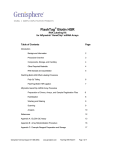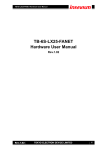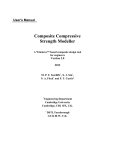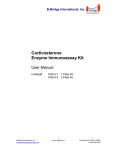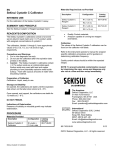Download Human Cystatin C Enzyme Immunoassay Kit - B
Transcript
B-Bridge International, Inc. Human Cystatin C Enzyme Immunoassay Kit User Manual Catalog# K3012-1 1 B-Bridge International, Inc. Human Cystatin C ELISA 110811 TABLE OF CONTENTS Intended Use 3 Background 3 Assay Principle 3 Kit Components 3 Materials Required 4 Precautions 4 Reagent Preparation 4 Sample Preparation 5 Assay Protocol 5 Calculations 6 Typical Standard Curve: Example 6 Notice to Purchaser This product is to be used for Research Purposes Only. It is not to be used for Drug or Diagnostic Purposes, nor is it intended for Human Use. B-Bridge products may not be resold, modified for resale, or used to manufacture commercial products without the express written consent of B-Bridge International, Inc. EXCEPT AS OTHERWISE EXPRESSLY SET FORTH IN THIS USER MANUAL, B-BRIDGE DOES NOT MAKE ANY REPRESENTATION OR WARRANTIES OR CONDITIONS OF ANY KIND, EITHER EXPRESSED OR IMPLIED, WITH RESPECT TO THE PRODUCTS, OR INFORMATION DISCLOSED HEREUNDER, INCLUDING, BUT NOT LIMITED TO, THE IMPLIED WARRANTIES OF MERCHANTABILITY, FIT FOR A PARTICULAR PURPOSE, OR NONINFRINGEMENT OF THE INTELLECTUAL PROPERTY RIGHTS OF THIRD PARTIES. B-Bridge International, Inc. All Rights Reserved. 2 B-Bridge International, Inc. Human Cystatin C ELISA 110811 INTENDED USE The B-Bridge Human Cystatin C ELISA kit (catalog # K3012-1) is designed to quantitatively measure human Cystatin C present in serum, EDTA and Heparin plasma, urine, and tissue culture media; samples containing visible particulate should be centrifuged prior to using. This assay has been shown to detect Cystatin C from human samples only. Please read the complete kit insert before performing this assay. BACKGROUND Cystatin C is a non-glycosylated protein of low molecular weight (13kDa) in the cystatin superfamily. Cystatin C is produced at a constant rate in all nucleated cells, secreted from cells and thus found in detectable amounts in most body fluids. Cystatin C belongs to the cysteine proteinase inhibitor group and is associated with several pathological conditions. Imbalance between Cystatin C and cysteine proteases is associated with diseases such as inflammation, renal failure, cancer, Alzheimer’s disease, multiple sclerosis and hereditary Cystatin C amyloid angiopathy. Increased levels have been found in autoimmune diseases, with colorectal tumors and metastases, patients with inflammation and in patients on dialysis. Cystatin C is removed from blood plasma by glomerular filtration in the kidneys. It is reabsorbed by the proximal tubular cells and degraded. There is a linear relationship between the reciprocal Cystatin C concentration in plasma and the glomerular filtration rate (GFR). Cystatin C is suggested to be a better marker for GFR than the ubiquitous serum creatinine marker as its serum concentration is not affected by other factors such as age, gender and body mass and Cystatin C has higher sensitivity to detect a reduced GFR than creatinine determination. Low levels of Cystatin C are found with the breakdown of the elastic laminae and atherosclerosis and abdominal aortic aneurysm. There is evident association of Cystatin C levels with the incidence of myocardial infarction, coronary death and angina pectoris, presenting a risk factor for secondary cardiovascular events. ASSAY PRINCIPLE The B-Bridge Human Cystatin C ELISA Kit is designed to measure Cystatin C present in human biological samples and tissue culture media. Standards or diluted samples are pipetted into a clear microtiter plate coated with a mouse anti-human Cystatin C monoclonal antibody. After a 60 minute incubation, the plate is washed and a peroxidase conjugated Cystatin C monoclonal antibody is added. After incubation and washing, substrate is added to the plate. The plate is read at 450 nm wavelength and concentration of Cystatin C in the sample is calculated using software available with most plate readers. KIT COMPONENTS Clear Coated 96-well plate One Plate Cystatin C Standard (400ng/mL) 60 uL Cystatin C Conjugate 5 mL 5X Assay Buffer Concentrate 28 mL 20X Wash Buffer Concentrate 30 mL TMB Substrate 5 mL Stop Solution 5 mL - 1N hydrochloric acid solution (HCl). CAUSTIC Plate Sealer 1 each Store above components at 4°C 3 B-Bridge International, Inc. Human Cystatin C ELISA 110811 MATERIALS REQUIRED BUT NOT SUPPLIED - Supply of distilled or deionized water - Microplate washer - Colorimetric 96-well microplate reader capable of reading OD at 450 nm with correction between 570 and 590 nm. - Software for converting raw relative fluorescent unit (FLU) readings from the plate reader and carrying out four parameter logistic curve (4PLC) fitting PRECAUTIONS For in vitro research use only. Read and understand the complete user manual before attempting to use the product. As with all such products, this kit should only be used by qualified personnel who are experienced in routine laboratory procedures and safety practices. The Cystatin C Standard is purified from a human source and should be treated as potentially hazardous. Proper safety procedures must be followed. The Stop Solution is 1N hydrochloric acid. Appropriate precautions should be observed when handling this caustic solution. Avoid contact with skin or eyes. Wear gloves and laboratory coats when handling materials and, in all cases, please consult your institution’s safety procedures for working with hazardous chemicals. REAGENT PREPARATION Allow the kit reagents to come to room temperature for 30 minutes. We recommend that all standards and samples be run in for accurate determination of Cystatin C concentrations. Ensure that all samples have reached room temperature and have been diluted as appropriate prior to running them in the kit. Assay Buffer Dilute Assay Buffer Concentrate 1:5 by adding one part of the concentrate to four parts of deionized water. Once diluted this is stable at 4°C for 3 months. Wash Buffer Dilute 20X Wash Buffer 1:20 by adding one part of the concentrate to nineteen parts of deionized water. Once diluted this is stable at room temperature for 3 months. Standard Preparation Using the Cystatin C stock at (400 ng/mL), prepare a series of 7 standards by serial dilution as follows, referring to the below table. Label seven glass test tubes as #1 through #7. Briefly spin vial of standard in a microcentrifuge to ensure contents are at the bottom of the vial. - Pipet 585 µL of Assay Buffer into tube 1 and 250 µL into tubes 2 to 7. - Add 15 µL of the Cystatin C stock solution to tube 1 and vortex completely. - Take 250 µL of the Cystatin C solution in tube 1 and add it to tube 2 and vortex completely. Repeat the serial dilutions for tubes 3 through 7. - The concentration of Cystatin C in tubes 1 through 7 will be 10, 5, 2.5, 1.25, 0.625, 0.313, and 0.156 ng/mL. Use all Standards within 2 hours of preparation. 4 B-Bridge International, Inc. Human Cystatin C ELISA 110811 Reagent Assay Buffer Volume Cystatin C Stock Standard 1 Standard 2 Standard 3 Standard 4 Standard 5 Standard 6 Final Concentration (ng/mL) Standard 1 585 µl 15 µl Standard 2 250 µl Standard 3 250 µl Standard 4 250 µl Standard 5 250 µl Standard 6 250 µl Standard 7 250 µl 250 µl 250 µl 250 µl 250 µl 250 µl 250 µl 10 5 2.5 1.25 0.625 0.313 0.156 SAMPLE PREPARATION This assay has been validated for human serum, EDTA and heparin plasma, urine and tissue culture media samples. Samples containing visible particulate should be centrifuged prior to using. This assay has been shown to detect Cystatin C from only human samples. Use samples within 2 hours of dilution. Serum and Plasma Samples Serum and plasma samples must be diluted at least 1:50 with the provided Assay Buffer immediately prior to use. A dilution of at least 1:225 is recommended to detect most samples within the standard curve range. Disease state samples (e.g. sample from tubular kidney disease) may require further dilutions up to 1:500 or greater. Appropriate sample dilutions should be determined empirically. Urine Samples Urine samples must be diluted at least 1:4 with the provided Assay Buffer prior to use with the kit. Tissue Culture Media Tissue culture medium samples should be diluted in tissue culture medium and read off a standard curve generated in the same culture medium. ASSAY PROTOCOL Standards and samples should be run in duplicate 1. Pipet 50 µL of sample or standard into each well. Pipet 50 µL of Assay Buffer into the zero standard wells. 2. Incubate at room temperature for 60 minutes. Aspirate the plate and wash 4 times with the wash buffer. Tap the plate dry on absorbent towels. 3. Add 50 µL of the Cystatin C Conjugate to each well, using a repeater or multi-channel pipet. 4. Incubate at room temperature for 30 minutes 5. Aspirate the plate and wash 4 times with the wash buffer. Tap the plate dry on absorbent towels. 6. Add 50 µL of the TMB Substrate to each well, using a repeater or a multichannel pipet. 7. Incubate at room temperature for 30 minutes. 8. Add 50 µL of the Stop Solution to each well. 9. Read the optical density at wavelengths 450 nm with correction between 570 and 590 nm. 5 B-Bridge International, Inc. Human Cystatin C ELISA 110811 CALCULATIONS Average the duplicate OD readings for each standard and sample. Create a standard curve by reducing the data using computer software capable of generating a four-parameter logistic curve (4PLC) fit. The sample concentrations should be multiplied by the dilution factor to obtain neat sample values. TYPICAL STANDARD CURVE: EXAMPLE ONLY Standard curves vary with each assay. Always run your own standard curves for calculation of results; do not use this data. 6 B-Bridge International, Inc. Human Cystatin C ELISA 110811






